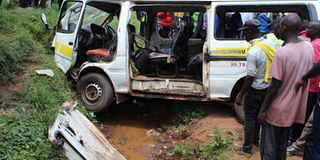Daraja Moja - The deadly spot where 150 have lost lives

The wreckage of a matatu that was involved in an accident on the Nyamira-Kisii highway at Daraja Moja bridge. According to the region’s traffic police commandant, Mr Francis Kithinji, more than 150 people have been killed on the stretch in the last fifteen years alone. PHOTO | BENSON MOMANYI | NATION MEDIA GROUP
What you need to know:
- Riddled with potholes and craters, the Daraja Moja – Nyamataro road is an eyesore, an accident-prone tarmac stretch, posing a deadly risk to users.
- Come the rainy season and the road is at its most lethal, with numerous motorbike and matatu crashes being the order of the day.
It has been called the death trap of Kisii Town.
Riddled with potholes and craters, the Daraja Moja–Nyamataro road is an eyesore, an accident-prone tarmac stretch, posing a deadly risk to users.
According to the region’s traffic police commandant, Mr Francis Kithinji, more than 150 people have been killed on the stretch in the last fifteen years alone.
“This works out to an average of ten people annually,” he told the Daily Nation.
Gaping potholes, eroded embankments and muddy, flooded sections are the main landmarks that characterise the road that has been a source of grief to many Kisii residents.
The short trip along the three-kilometre stretch is a dance with death that twists the driver through a series of zigzag moves to avoid the potholes.
“We have to drive very slowly along this stretch if we are to make it safely to the other side,” Mr Nicholas Onyancha, a driver, observed.
Come the rainy season and the road is at its most lethal, with numerous motorbike and matatu crashes being the order of the day.
The stretch passing outside Kenya Power offices and a section of the road next to the Nyamataro shopping centre are always flooded as the drainage does not work.
Earlier this year, Kisii Governor James Ongwae absolved the county administration of blame regarding the road.
“It is a publicly known fact that the road is under the jurisdiction of the Kenya Urban Roads Authority. We have requested their officials to look into it. They have promised to recarpet the road and fix the drainage but this is yet to happen,” he said.
Recently, youth from Kitutu Chache sub-county carried out minimal repairs at the flooded section of the road.
ACCIDENT VICTIMS
Mrs Joyce Moraa was a trader at Daraja Mbili market until disaster struck during the Daraja Moja bridge accident of August 31, 2007.
She used to sell mitumba clothes and it all came to an end one day as she was heading home.
“When we arrived at the bridge, I had already fallen asleep. I was awoken by a loud bang and screams from fellow passengers. The next thing I knew, our matatu had plunged over the bridge,” she said.
“My immediate instinct was to get out of the vehicle but when I tried to move, I felt a sharp pain shoot through my right leg.”
Her leg was trapped between two seats that had been pushed together by the impact of the collision.
The mitumba trader was just one of the lucky survivors in the horror smash that involved five vehicles and resulted in 30 deaths.
She would spend an agonising eight months in hospital.
“My right leg had to be amputated as a result of the accident. I lost my business as well as most of my income catering for my treatment,” she said. The whole ordeal cost her more than Sh600,000.
Consultant optician Dr Abunga points to a number of graves located at his cousins’ home at Taracha.
“I lost five relatives during that accident. As a family, we had to carry out a joint burial ceremony since the cost and emotional toll of burying them separately would have been too much to bear,” he said.





